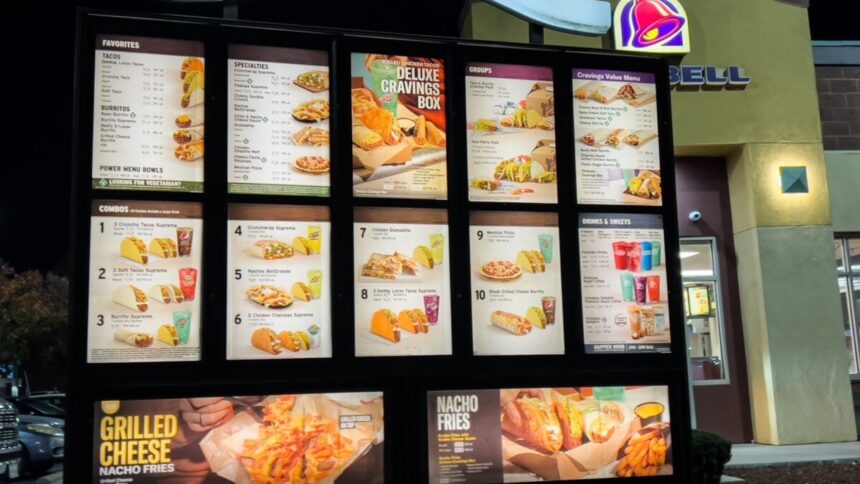You’ve seen them before. McDonald’s brings back the McRib. Disney rolls out a limited time only specialty menu. Starbucks uses social media codes to “unlock” new drinks and combinations. And of course, there was Burger King’s Whopperito.
Now, Taco Bell is once again getting back into the game, saying Friday that it will bring back a special “Y2K” menu with nostalgia-based items from the ’60s to the ’90s. That includes the Cool Ranch Doritos locos tacos, the 7-layer burrito, tostada, meximelt, and caramel apple empanada.
But as the social media around the “new” items went wild, the investors who put their money into companies that own fast food chains, like Yum Brands, are doing their own back-of-the envelop calculations on how much upside they can expect from novelty menus.
Executives generally hope that this throwback approach will boost traffic and sales, creating buzz in a competitive fast-food landscape where brands increasingly leverage nostalgia to differentiate themselves.
They also bet on FOMO: The limited-time menu will be available at participating stores nationwide, with some fans already predicting a viral resurgence of these classic items.
But does it make money?
The answer to what kind of boost investors can expect from a limited time offer depends on the brand. But consultants who follow the industry say that while some companies may see a 15% increase in their bottom line, it is ultimately the extra traffic that comes to a restaurant that pays off.
Take Burger King’s novelty item, the Mac n’ Cheetos, Jo Allison, a consumer behavioral analyst at Canvas8, a market research firm in London, told Forbes.
“It was only meant to stay on the menu for eight weeks but was an instant hit, selling out in restaurants across the U.S. and earning the brand over 3.2 billion online impressions, making it one of the most covered product launches in the company’s history,” Allison says.
That doesn’t mean it is always a minor success. McDonald’s popular $5 meal deal accounted for 9% of total sales in Q3 and Q4 of 2024, a study has found.
So how does it work?
Limited time only offers are a new twist on a longtime marketing gimmick used throughout the restaurant business.
Known as “menu engineering,” it is usually a strategic framework used by restaurants to analyze and optimize menu pricing, with the goal of enhancing profitability.
The process involves classifying each menu item into one of four categories based on sales volume and profit margins, and then applying principles of menu psychology to redesign and promote dishes more effectively.
According to Menu Cover Depot, ongoing menu engineering can lead to profit increases of approximately 10% to 15%. By understanding which items perform best and how presentation influences customer choices, restaurateurs can make data-driven decisions to maximize revenue and improve overall business performance.
Executives emphasize that staying ahead of the competition requires a proactive approach: continuously testing new offerings, refining existing items, and leveraging customer feedback. By doing so, brands can enhance the dining experience, boost sales, and build a loyal customer base in a crowded marketplace.
How much money can a menu like this make investors?
The specific monetary gains depend on factors like restaurant type, item costs, and how effectively the menu is implemented. A local restaurant will see different numbers than a worldwide chain, but here’s a general breakdown of how novelty menus boost revenue:
- Higher spending: Research shows that customers attending special events or ordering unique menu items are willing to spend significantly more. A National Restaurant Association survey found that diners attending special nights spend 30% more than regular patrons.
- Increased customer traffic: Limited-time offers (LTOs) and themed menus generate excitement and attract new customers. Data from Technomic shows that restaurants and bars hosting weekly events, such as theme nights, can see up to a 20% increase in traffic on slower days.
- Brand differentiation: Creative and memorable menus can set a business apart from its competitors, generating social media buzz and positive word-of-mouth that attract a broader audience.
- Encouraging specific choices: Using psychological principles, a novelty menu can strategically guide customers toward high-profit items.
Taco Bell is trying all kinds of things
The chain announced that it will feature user-generated custom orders and fan art across its marketing channels, aiming to connect more deeply with its social media audience amid ongoing challenges with AI-driven drive-thru technology.
This initiative follows recent setbacks in Taco Bell’s deployment of AI-powered voice ordering systems, which have been plagued by glitches and unpredictable interactions. Despite the technical hurdles, the company is trying to change the narrative by giving them foods they miss.
“Taco Bell has always thrived on its fans’ creativity,” said a company spokesperson in a statement. “By bringing fan art and custom orders into the spotlight, we’re celebrating the spirit of our community and reinforcing our fun, rebellious brand identity.”
Do novelty menus actually work?
In an increasingly competitive food industry, restaurants that prioritize menu innovation are more likely to attract new customers, foster loyalty, and stay ahead of food trends.
Modern diners seek out exciting flavors, bold combinations, and cutting-edge culinary concepts, making fresh offerings essential for appealing to foodies, trendsetters, and younger generations eager for unique dining experiences.
Keeping the menu fresh also plays a critical role in retaining existing customers. Seasonal and limited-time items generate anticipation, encouraging guests to return regularly to discover new dishes and strengthen their connection to the brand.
“These new foods will certainly generate buzz,” says Peggy Liu, an assistant business professor at the University of Pittsburgh’s Joseph M. Katz Graduate School of Business and College of Business Administration, told Forbes. “Will everyone find these novelty items appealing? Certainly not. However, we do know from research that there are some consumers who really value trying new experiences.”
Even if you don’t buy them, you probably still like them
Ultimately, it’s worth it because of the brand awareness it brings.
With consumer preferences evolving rapidly, menu innovation serves as a strategic tool to stay relevant. Whether introducing spicy honey, adventurous flavor pairings, or popular dietary trends, brands that adapt quickly can better meet customer demands and capitalize on emerging trends.
In a crowded marketplace packed with new concepts and rising competitors, continual innovation is crucial. A restaurant that surprises and delights customers with fresh, creative offerings gains a competitive edge, by drawing in new patrons and cementing loyalty among existing ones.
“(Customers) get bored very, very quickly,” Neil Saunders, CEO of retail research firm Conlumino, told USA TODAY. “You have to work increasingly hard to get the message across.”
Read the full article here












